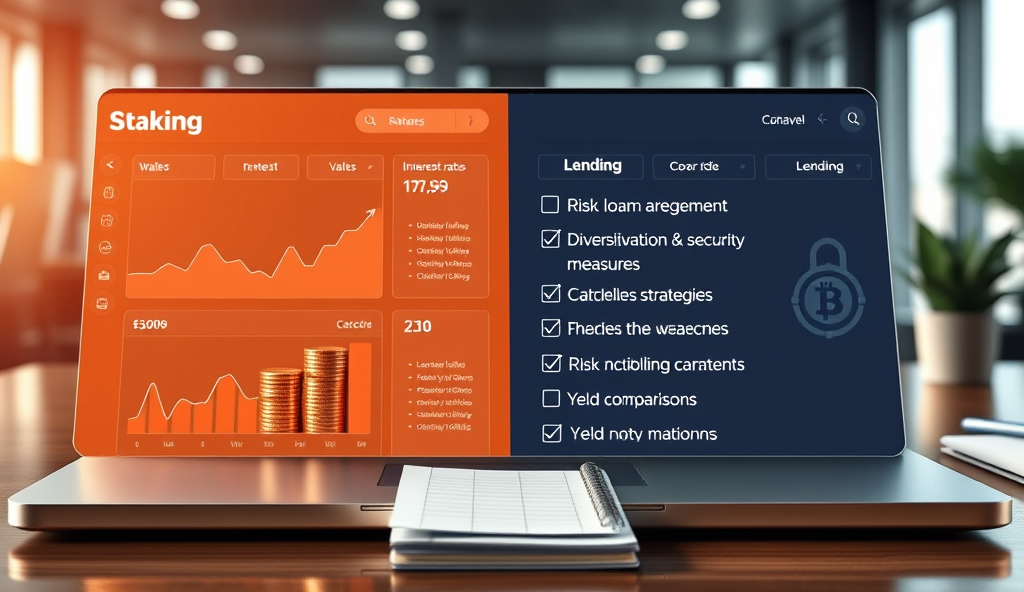Introduction to Staking vs Lending for Cryptocurrency Investors
Staking and lending offer distinct paths for crypto investors to generate passive income, with staking typically yielding 5-20% APY on proof-of-stake networks like Ethereum 2.0 while lending platforms such as Celsius historically offered 3-8% on stablecoins. The fundamental difference lies in staking’s network participation versus lending’s capital provision to borrowers, each carrying unique risk-reward profiles that demand careful evaluation.
For example, European investors favoring staking might lock ETH for validator rewards while Asian traders often prefer lending USDT on platforms like Binance for flexible withdrawals. These regional preferences highlight how liquidity needs and risk tolerance shape the staking vs lending decision, factors we’ll explore in detail throughout this comparison guide.
Understanding these core differences prepares investors for deeper analysis of staking mechanics in the next section, where we’ll examine validator requirements, slashing risks, and compound growth potential. Both strategies require balancing security considerations with yield optimization, a theme that will recur as we compare their tax implications and custody solutions.
Key Statistics

Understanding Staking in Cryptocurrency
Staking involves locking crypto assets to validate transactions on proof-of-stake blockchains with Ethereum 2.0 requiring 32 ETH for validator participation while platforms like Kraken allow pooled staking with lower minimums.
Staking involves locking crypto assets to validate transactions on proof-of-stake blockchains, with Ethereum 2.0 requiring 32 ETH for validator participation while platforms like Kraken allow pooled staking with lower minimums. This process generates 5-20% APY but introduces slashing risks where validators lose funds for network violations, making security protocols critical for yield optimization.
European investors often stake through regulated platforms like Coinbase for compliance assurance, whereas Asian traders favor high-yield DeFi staking on PancakeSwap despite higher smart contract risks. These regional approaches reflect varying priorities between institutional-grade security and maximized returns, a key consideration when comparing staking vs lending options.
The locked capital requirement distinguishes staking from lending’s flexible withdrawals, though compounding rewards can offset liquidity constraints over time. Next, we’ll examine how lending platforms offer different risk parameters through collateralized loans and variable interest rates, completing the staking vs lending comparison.
Understanding Lending in Cryptocurrency
Unlike staking's network participation rewards crypto lending generates yield by supplying assets to borrowers through platforms like Celsius or Aave with interest rates varying from 1% to 12% based on market demand and collateralization ratios.
Unlike staking’s network participation rewards, crypto lending generates yield by supplying assets to borrowers through platforms like Celsius (before its 2022 collapse) or Aave, with interest rates varying from 1% to 12% based on market demand and collateralization ratios. Institutional lenders often use overcollateralized loans (125-150% LTV) on BlockFi to mitigate default risks, while Asian retail traders frequently opt for undercollateralized DeFi options like Venus Protocol for higher yields.
Lending platforms offer flexible withdrawal options compared to staking’s lock-up periods, though sudden market crashes can trigger liquidations, as seen when $880 million was wiped out during Terra’s collapse. European platforms like Nexo now integrate mandatory risk disclosures and cooling-off periods to comply with MiCAR regulations, contrasting with less regulated Asian markets where platforms offer 15% APY on stablecoins.
The choice between staking and lending often hinges on liquidity needs versus yield optimization, with lending’s variable rates reacting faster to market conditions than staking’s protocol-fixed rewards. Next, we’ll dissect the key differences between staking and lending, including risk parameters and reward structures that shape investor decisions across jurisdictions.
Key Differences Between Staking and Lending
Staking rewards stem from validating blockchain transactions offering fixed APYs like Ethereum's 3-5% while lending yields fluctuate with market demand exemplified by Aave's USDC rates swinging between 2-8% weekly.
Staking rewards stem from validating blockchain transactions, offering fixed APYs like Ethereum’s 3-5%, while lending yields fluctuate with market demand, exemplified by Aave’s USDC rates swinging between 2-8% weekly. Unlike staking’s protocol-enforced lock-ups, lending platforms like Nexo allow instant withdrawals, though this liquidity comes with higher volatility risks during market downturns.
Collateral requirements diverge sharply, with staking requiring native tokens (e.g., 32 ETH for solo validation) versus lending’s flexible collateral options, including stablecoins or NFTs on platforms like JPEG’d. European lenders face stricter MiCAR-mandated safeguards, whereas Asian markets tolerate riskier undercollateralized loans for higher returns, creating jurisdictional yield disparities.
Reward mechanisms differ fundamentally—staking payouts are blockchain-native tokens (ETH for Ethereum), while lending yields are typically paid in the deposited asset or platform tokens like COMP. These structural variances directly influence investor choices, setting the stage for examining risk factors in the next section.
Risk Factors in Staking vs Lending
Staking carries protocol-specific risks like slashing penalties for validator downtime while lending exposes users to counterparty defaults as seen when Celsius Network froze withdrawals during its liquidity crisis.
Staking carries protocol-specific risks like slashing penalties (up to 1 ETH per violation on Ethereum) for validator downtime, while lending exposes users to counterparty defaults, as seen when Celsius Network froze withdrawals during its liquidity crisis. The fixed APYs in staking offer stability but become problematic during bear markets when token values plummet, unlike lending’s variable rates that adjust to market conditions.
Geographical risks vary significantly, with European lenders complying with MiCAR’s 1:1 collateral rules while Asian platforms like Hodlnaut previously offered riskier undercollateralized loans before regulatory crackdowns. Staking’s native token requirement (e.g., 32 ETH) creates concentrated exposure, whereas lending’s diversified collateral options spread risk across assets like stablecoins or NFTs.
Smart contract vulnerabilities present universal threats, evidenced by the $325 million Wormhole bridge hack affecting staked assets, though lending platforms face additional oracle manipulation risks like the $80 million Mango Markets exploit. These risk profiles directly influence reward potential, which we’ll analyze next.
Reward Potential in Staking vs Lending
Choosing between staking and lending ultimately depends on your risk tolerance investment horizon and technical comfort level as highlighted throughout our staking vs lending comparison guide.
Staking rewards typically range from 3-20% APY on major networks like Ethereum (3.8%) and Solana (7.5%), offering predictable returns tied to network security needs, whereas lending yields fluctuate between 1-15% based on market demand, with platforms like Aave offering 4.2% on USDC versus Celsius’ now-defunct 8.8% rates. These differences stem from staking’s protocol-level inflation mechanisms versus lending’s market-driven interest models.
Geographical variations impact yields significantly, with EU-regulated platforms like Nexo offering 8% on staked ETH versus Asian exchanges like Bybit providing 12% for flexible staking, reflecting regional risk appetites. Lending platforms show similar disparities, with US-based BlockFi historically offering 4.5% on BTC loans compared to Singapore’s Hodlnaut’s 7% before its collapse.
The reward structures directly affect liquidity accessibility, which becomes crucial when comparing lock-up periods in staking (weeks to years) versus lending’s typically shorter terms (days to months). This liquidity-flexibility tradeoff shapes overall returns and will be examined next.
Liquidity Considerations for Staking and Lending
Staking typically imposes longer lock-up periods, with Ethereum 2.0 requiring 18-24 months for validator withdrawals, while Solana offers flexible staking with 2-3 day unbonding periods, creating stark liquidity differences compared to lending platforms like Aave where funds can be withdrawn instantly. These constraints directly impact emergency access to capital, making staking less suitable for investors needing short-term liquidity.
Lending platforms provide more flexibility, with Celsius (pre-collapse) offering daily withdrawals versus BlockFi’s weekly limits, though both options pale against staking’s rigid timelines. The tradeoff becomes clear when comparing Binance’s 7% APY for 90-day locked staking versus their 3% flexible savings product, highlighting how yield potential increases with reduced liquidity.
These liquidity differences significantly influence risk management strategies, particularly during market volatility when quick exits may be necessary, setting the stage for examining platform security in the next section.
Security Aspects of Staking and Lending Platforms
While liquidity constraints shape risk management, security vulnerabilities present another critical layer in the staking vs lending comparison. Staking platforms like Ethereum 2.0 rely on decentralized validator nodes, reducing single-point failures but exposing users to slashing risks if validators misbehave, with penalties reaching 1 ETH per incident.
In contrast, centralized lending platforms like Celsius faced catastrophic collapses due to poor risk management, highlighting custodial risks absent in non-custodial staking.
Smart contract vulnerabilities also differ, with lending protocols like Aave suffering $25M in exploits in 2022 while staking contracts remain simpler but face validator centralization threats. Binance’s staking service maintains a 98% uptime but requires trusting exchange custody, whereas Solana’s decentralized staking distributes risk across 1,900+ validators, offering different security tradeoffs.
These distinctions become vital when evaluating platform reliability during market stress.
Understanding these security dynamics informs asset allocation decisions, especially when considering how platform risks interact with the tax implications explored next. Investors must weigh technical risks against operational ones, as both staking and lending carry unique exposure profiles beyond just yield potential.
Tax Implications of Staking vs Lending
The security risks discussed earlier directly impact tax treatment, as staking rewards are typically taxed as income upon receipt while lending interest may be deferred until withdrawal in some jurisdictions. For example, US investors must report staking rewards at fair market value when received, whereas platforms like BlockFi treated interest payments similarly before their collapse.
Validator slashing penalties in staking can sometimes be claimed as capital losses, contrasting with lending defaults which may qualify as bad debt deductions under specific conditions. Countries like Germany tax staking rewards at 25% flat rate while Singapore exempts them, highlighting how regional variations interact with the security tradeoffs analyzed previously.
These tax considerations become crucial when evaluating net returns after accounting for both platform risks and fiscal obligations, setting the stage for choosing between staking and lending based on individual circumstances. The next section will explore decision frameworks that incorporate these financial and operational factors.
How to Choose Between Staking and Lending
Given the tax implications and security risks outlined earlier, investors should prioritize aligning their choice with personal risk tolerance and financial goals. For example, staking suits those comfortable with lock-up periods and validator selection, while lending appeals to investors seeking flexible withdrawals despite counterparty risks.
Consider net APY after taxes, as German investors face 25% on staking rewards versus Singapore’s tax-free treatment, significantly altering real returns. Lending platforms like Celsius offered 8-12% APY pre-collapse, but post-tax yields often fell below staking rewards in jurisdictions with favorable crypto policies.
The next section will break down a step-by-step checklist for evaluating staking options, building on these comparative frameworks. This ensures investors systematically assess variables like slashing risks and reward schedules before committing funds.
Step-by-Step Checklist for Evaluating Staking Options
First, assess validator reliability by reviewing historical uptime and slashing incidents, as even top platforms like Ethereum 2.0 impose 1-5% penalties for downtime. Compare lock-up periods across networks, noting Polkadot’s 28-day unbonding versus Solana’s instant withdrawals, aligning with your liquidity needs.
Next, calculate net APY after local taxes, remembering German investors lose 25% of rewards while Singaporean participants keep full yields from platforms offering 5-15%. Verify reward distribution schedules—Cosmos pays daily whereas Cardano compounds weekly—impacting compounding strategies.
Finally, audit security measures, prioritizing cold-staking options like Ledger Live integration over hot wallets, reducing exposure to exchange hacks. This systematic approach prepares investors for the subsequent lending options evaluation, where counterparty risk replaces technical considerations.
Step-by-Step Checklist for Evaluating Lending Options
Begin by analyzing platform solvency, as Celsius’s 2022 collapse proved even 17% APY offers vanish if counterparties default. Compare interest payment structures, noting BlockFi’s tiered rates (3-8% APY) versus Aave’s variable yields (1-12%) based on pool demand, mirroring the tax-aware APY calculations discussed earlier for staking.
Prioritize platforms with verifiable collateralization, like Nexo’s 145% loan-to-value buffers, over unsecured options, just as cold storage reduced staking risks. Confirm withdrawal flexibility—Kraken processes loans instantly while Celsius imposed 90-day freezes—paralleling Polkadot’s unbonding period considerations from earlier sections.
Finally, cross-reference insurance coverage; Gemini’s $200M custodial protection contrasts with uninsured DeFi pools, echoing the security audits emphasized in staking. This due diligence framework naturally leads to examining pitfalls in both strategies next.
Common Mistakes to Avoid in Staking and Lending
Overlooking platform solvency checks remains a critical error, as evidenced by Celsius users losing access to funds despite attractive APYs, reinforcing the need for the due diligence framework outlined earlier. Many investors also fail to account for tax implications, particularly with variable DeFi yields like Aave’s, which complicate annualized returns compared to BlockFi’s tiered rates.
Ignoring withdrawal restrictions can trap assets, as seen when Celsius imposed 90-day freezes—a risk mirroring Polkadot’s 28-day unbonding period discussed previously. Similarly, overexposure to uninsured DeFi pools, despite higher yields, neglects the security benefits of Gemini’s $200M custodial protection or Nexo’s collateralized loans.
Chasing unsustainable APYs without verifying collateralization, like Nexo’s 145% buffers, often leads to losses, just as staking without cold storage compromises security. These pitfalls highlight why monitoring tools, covered next, are essential for managing both strategies effectively.
Tools and Resources for Monitoring Staking and Lending
Platforms like DeFiLlama and Staking Rewards provide real-time APY comparisons across 200+ protocols, helping investors avoid unsustainable yields like Celsius’s pre-collapse rates. For security monitoring, tools such as CertiK Skynet audit smart contracts, while Nansen tracks wallet movements to detect insolvency risks early—critical for platforms with less transparency than Gemini’s insured custodial solutions.
Tax-specific tools like Koinly automatically categorize variable DeFi earnings from Aave or Compound, addressing the reporting complexities highlighted earlier. Cold storage integrations with Ledger Live allow secure staking delegation, mitigating the risks of hot wallet compromises that plague unprotected validators.
Custom dashboards using Glassnode’s on-chain data can alert users to Polkadot’s unbonding period changes or Nexo’s collateral ratio fluctuations, enabling proactive adjustments. These resources form the foundation for making an informed decision between staking and lending strategies, which we’ll explore next.
Conclusion: Making an Informed Decision Between Staking and Lending
Choosing between staking and lending ultimately depends on your risk tolerance, investment horizon, and technical comfort level, as highlighted throughout our staking vs lending comparison guide. While staking offers higher potential rewards (often 5-15% APY) for those willing to lock assets, lending provides more flexibility with platforms like Celsius historically offering 3-8% on stablecoins.
Consider combining both strategies—staking long-term holdings while lending liquid assets—to balance security and accessibility, as many Asian investors do with Ethereum staking and USDC lending. Always verify platform credibility, as evidenced by the 2022 Celsius collapse, and align choices with your overall crypto portfolio strategy.
The decision hinges on whether you prioritize network participation (staking) or capital preservation (lending), with tax implications varying by jurisdiction—staking often treated as income, lending as interest. Diversification across both methods, while monitoring smart contract risks and market conditions, remains the wisest approach for sustainable passive income in volatile crypto markets.
Frequently Asked Questions
What's the main risk difference between staking and lending?
Staking risks include slashing penalties for validator downtime while lending exposes you to platform insolvency like Celsius' collapse – always check CertiK audits before committing funds.
How do tax treatments differ for staking vs lending rewards?
Staking rewards are typically taxed as income upon receipt while lending interest may be deferred – use Koinly to track both across jurisdictions for accurate reporting.
Can I access my funds quickly with staking like I can with lending?
No – staking often has lock-up periods (Ethereum 2.0 requires 18-24 months) while lending platforms like Aave allow instant withdrawals but check withdrawal limits first.
Which offers higher yields generally: staking or lending?
Staking typically yields 5-20% APY on major networks while lending varies more (1-15%) – compare real-time rates on Staking Rewards and DeFiLlama before deciding.
How can I minimize risks when choosing a staking platform?
Prioritize platforms with cold storage options like Ledger Live integration and check validator uptime stats – avoid exchanges with poor security histories regardless of APY promises.





